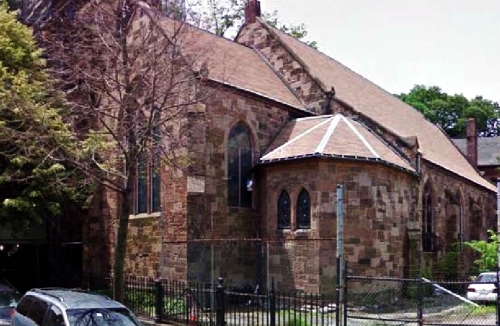Building of the Day: 230 Classon Avenue
Brooklyn, one building at a time. Name: St. Mary’s Episcopal Church Address: 230 Classon Avenue Cross Streets: Willoughby and Myrtle Avenue Neighborhood: Clinton Hill Year Built: 1858-1859 Architectural Style: Gothic Revival Architect: Richard T. Auchmuty Landmarked: Yes, Individual landmark (1981) The story: The Brooklyn Navy Yard began drawing people into a community of homes as…

Brooklyn, one building at a time.
Name: St. Mary’s Episcopal Church
Address: 230 Classon Avenue
Cross Streets: Willoughby and Myrtle Avenue
Neighborhood: Clinton Hill
Year Built: 1858-1859
Architectural Style: Gothic Revival
Architect: Richard T. Auchmuty
Landmarked: Yes, Individual landmark (1981)
The story: The Brooklyn Navy Yard began drawing people into a community of homes as early as the 1820’s. Dock workers, tradesmen, chandlers and blacksmiths, and more; all of the skilled and unskilled workers who came to the Navy Yard to work, found the Wallabout area a fine place to live, and modest homes were built to meet those needs. Spiritual needs were important, too, and churches were established, most the offshoots of more established Brooklyn congregations. St. Mary’s Protestant Episcopal Church was one of these, established in 1835, by five members of St. John’s Episcopal Church, on Washington Street. At the time, Classon Avenue and the surrounding area was known as East Brooklyn, and was sparsely populated, so the first congregants met in a former schoolhouse located on Flushing Avenue. In 1837, St. Mary’s built its first church, a small frame building on Classon, north of Myrtle.
Most of the congregants of St. Mary’s were poor, so the church was one of the first Episcopal churches in New York to institute a system of free pews. It was the habit of most Episcopal churches in the 19th century to charge a pew rent, thereby paying for maintenance and upkeep, and insuring membership, but many families were too poor, and therefore could not belong to the congregation. Free pews did not go over well with many, (those not at St. Mary’s, of course) and even the Manhattan press reported that this system would eventually fail. It didn’t.
By 1858, St. Mary’s had outgrown its small chapel, and land was purchased one block away, on Classon Avenue, for a new church. They hired the firm of Renwick and Auchmuty, and as prominent as James Renwick was, it has been established that Auchmuty designed the church, although Renwick greatly contributed to the interior design. Richard Tylden Auchmuty was a descendant of one of NY’s oldest families. He studied at Columbia, and then at Renwick’s office, where he learned from the master about Gothic Revival architecture, before becoming a junior partner. Later, during the Civil War, he became a Colonel in the Union Army, where he suffered a debilitating leg wound, which years later caused his leg to be amputated.
After the war, in 1867, he married Ellen Schermerhorn, of the Brooklyn Schermerhorn’s, and Auchmuty left the architectural field to devote his time to philanthropy. He and Ellen were both independently wealthy, and they sponsored a number of charitable ventures, including the establishment of the New York Trade Schools, in 1881, which trained young students not only marketable trade skills, but the science and technical background to go with it. They summered in Lenox, MA, where they were prominent and generous community members, founding and running the Lenox Community Improvement Committee, and building that town’s Trinity Episcopal Church.
Auchmuty designed a beautiful Gothic Revival Church, special, in part, because of its adherence to the mid-19th century philosophy of ecclesiology, which laid out strict rules for the design of Episcopal churches, taking them back to the original Gothic designs that were at the heart of the medieval church. Auchmuty’s design for the entryway of the church, incorporating a flying buttress entry gate is especially good.
The church is probably one of Brooklyn’s least well known churches, especially landmarked churches, and is sometimes thought to be part of the Roman Catholic convent complex across the street, but there is no connection. It’s a near-forgotten architectural gem, lauded in 1859 in the Churchman, an Episcopalian periodical, as “to our taste, this is the most beautiful church in Brooklyn, though it has not the appliance of some of the more wealthy parishes.” Built to serve a working class community in the mid-19th century, it still serves, 160-some years later. GMAP









MM, this is a great church. Great massing, Great tower and steeple. Top notch all the way. Thank you for showcasing this hidden masterpiece.